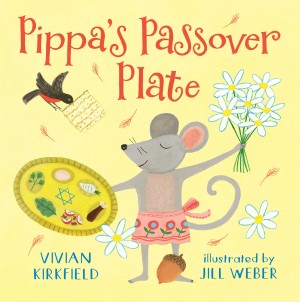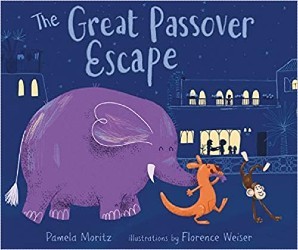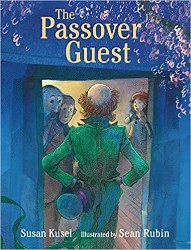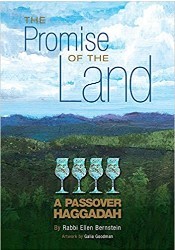Noa is an elementary school student who enjoys trading lunch items as much as any of her classmates. When Passover arrives, she has a problem. Her friends cannot understand why she suddenly rejects their well-intentioned offers of tasty foods, and Noa feels awkward. “‘Thanks,’ says Noa. ‘Not today. My lunch was made a special way.’” That italicized “My” does not indicate any sense of superiority. Lauren Gallegos’s picture shows Noa with eyes turned to one side and hands placed in front of her, palms forward, as if afraid of committing a transgression. Sometimes being Jewish requires a little explaining. Gallegos and author Jamie Kiffel-Alcheh have created an affirmative story about concern and interest among friends who may have different cultures but share the values of kindness and respect.
From the foods that Noa’s friends offer to share with her — chicken salad and pot roast in addition to garlic bread and cheese — it would seem that she normally interprets Jewish dietary laws loosely. Yet, during Passover, she refuses anything not prepared in her own home. Given that Jews have a wide and sometimes idiosyncratic approach to kashrut, it is plausible that, in Noa’s family, Passover is when they draw the line. Once readers accept that premise, Noa’s dialogue with her friends about the holiday which her family celebrates is entirely credible, and a lovely example of multicultural exchange.
Noa herself is from a biracial family and her friends form a diverse group. One girl wears a hijab. The environment of her school implies that her religious practice should not necessarily stand out as particularly unusual. Nevertheless, she is tentative about explaining her special lunch. Gallegos portrays the cafeteria as a dynamic setting, with students reaching across to one another in a kind of assembly line of production, creating their meals from one another’s different offerings. When Noa opens her lunchbox as if it were a treasure chest, everyone leans forward eagerly to see what it contains: “’Might be bread,’ says one girl, Pat. ‘but with holes — and really flat.’”
Noa then places her matzah in the context of history. The narrative flashes back to ancient Egypt where the Hebrew slaves are pictured with dark skin, drawing a parallel to the community where she lives. The bright colors of the present switch to shades of brown and yellow in the desert, until the Israelites escape and green sea waters rise and swirl dramatically around them. When the Exodus story concludes, her appreciative audience leaves. Noa wonders how she might best communicate with them about what Passover means today. The answer is matzah. After she serves it to her friends, the exotic unleavened bread becomes a delicious alternative to the ordinary. Soon they are enjoying it in every form, from pizza to chocolate, in a veritable “craze” of sharing.
Gallegos’s children are visually endearing, their faces expressing both kindness and excitement. Her delicate drawings of specific foods and utensils give a tangible feeling to a somewhat idealized world. All the children are similarly supportive to Noa, but a bunch of purple grapes neatly placed on a white napkin, and a matzah sandwich overstuffed with salad ingredients, add an individualized dimension to this parable of acceptance. The composition of the pictures also conveys a message, as in one wordless page where Noa serves different foods to different children in three separate illustrated segments. Children will understand that the flat crunchy bread with holes may be delicious, but the commitment of friends to accommodate and embrace each other’s differences is most important.
Emily Schneider writes about literature, feminism, and culture for Tablet, The Forward, The Horn Book, and other publications, and writes about children’s books on her blog. She has a Ph.D. in Romance Languages and Literatures.





